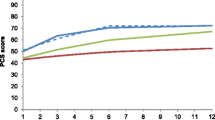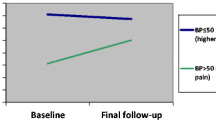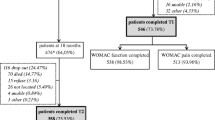Abstract
Summary
This study examined how depression risk interfaces with health outcomes of hip-fractured patients during the first year after hospital discharge. Physical function recovery and health outcome trajectories were much poorer for hip-fractured elders with persistent depression risk than for those with transitory and no risk for depression.
Introduction
This study examined how depression risk interfaces with the trajectories of physical activities and health-related quality of life (HRQoL) among hip-fractured elderly patients during the first 12 months after hospital discharge.
Methods
Based on 12-month scores for the Chinese version of Geriatric Depression Scale, patients over age 60 years (N = 147) were classified as (a) at persistent risk for depression, (b) at transitory risk for depression, and (c) at no risk for depression. Outcomes were measured by the Chinese Barthel Index and Medical Outcomes Study Short Form, Taiwan version, and analyzed by the generalized estimating equations approach.
Results
Patients who were at persistent risk for depression (n = 46, 31.3%) had much less chance of recovering activities of daily living (OR = 0.16, CI = 0.06–0.42) and walking ability (OR = 0.09, CI = 0.04–0.21) than patients at no risk for depression (n = 36, 24.5%). The trajectories of SF-36 scores for the physical and mental health summary scales were significantly different among the three depression groups; those “at persistent risk for depression” were the poorest and those “at no risk for depression” were the best.
Conclusion
These results may provide a reference for developing timely assessments and interventions for hip-fractured elders at risk of depression.



Similar content being viewed by others
References
Holmes J, House A (2000) Psychiatric illness predicts poor outcome after surgery for hip fracture: a prospective cohort study. Psychol Med 30:921–929
Bond J, Gregson B, Smith M et al (1998) Outcomes following acute hospital care for stroke or hip fracture: how useful is an assessment of anxiety or depression for older people? Int J Geriatr Psychiatry 13:601–610
Kempen GI, Sanderman R, Scaf-Klomp W et al (2003) The role of depressive symptoms in recovery from injuries to the extremities in older persons. A prospective study. Int J Geriatr Psychiatry 18:14–22
Lenze EJ, Munin MC, Dew MA, Ormel J (2004) Adverse effects of depression and cognitive impairment on rehabilitation participation and recovery from hip fracture. Int J Geriatr Psychiatry 19:472–478
Mossey JM, Knott K, Craik R (1990) The effects of persistent depressive symptoms on hip fracture recovery. J Gerontol 45:M163–M168
Mutran EJ, Reitzes DC, Mossey J et al (1995) Social support, depression, and recovery of walking ability following hip fracture surgery. J Gerontol B Psychol Sci Soc Sci 50:S354–S361
Ostir GV, Goodwin JS, Markides KS et al (2002) Differential effects of premorbid physical and emotional health on recovery from acute events. J Am Geriatr Soc 50:713–718
Kleinman A (2004) Culture and depression. N Engl J Med 351:951–953
Plant EA, Sachs-Ericsson N (2004) Racial and ethnic differences in depression: the roles of social support and meeting basic needs. J Consult Clin Psychol 72:41–52
Burke WJ, Roccaforte WH, Wengel SP (1991) The short form of the Geriatric Depression Scale: a comparison with the 30-item form. J Geriatr Psychiatry Neurol 4:173–178
van Marwijk HW, Wallace P, de Bock GH et al (1995) Evaluation of the feasibility, reliability and diagnostic value of shortened versions of the geriatric depression scale. Br J Gen Pract 45(393):195–199
Fuh JL, Liu HC, Wang SJ et al (1997) Poststroke depression among the Chinese elderly in a rural community. Stroke 28:1126–1129
Chen YJ, Dai YT, Yang CT et al (eds) (1995) A review and proposal on patient classification in long-term care system. Department of Health, Republic of China, Taipei, Taiwan. (In Chinese)
Shyu YI, Chen MC, Liang J et al (2004) Predictors of functional recovery for hip fractured elders during 12 months following hospital discharge: a prospective study on a Taiwanese sample. Osteoporos Int 15:475–482
Lu JFR, Tseng HM, Tsai YJ (2003) Assessment of health-related quality of life in Taiwan (I): development and psychometric testing of SF-36 Taiwan version. Taiwan J Public Health 22:501–511
Tseng HM, Lu JFR, Tsai YJ (2003) Assessment of health-related quality of life in Taiwan (II): norming and validation of SF-36 Taiwan version. Taiwan J Public Health 22:512–518
Shyu YIL, Lu JR, Liang J (2004) Evaluation of Medical Outcomes Study Short-Form-36 Taiwan version in assessing elderly patients with hip fracture. Osteoporos Int 15:575–582
Ware JE, Kosinski MK, Keller SD (1994) SF-36 Physical and Mental Health Summary Scales: A User’s Manual. The Health Institute, New England Medical Center, Boston
Yip PK, Shyu YI, Liu SI et al (1992) An epidemiological survey of dementia among elderly in an urban district of Taipei. Acta Neurol Sinica 1:347–354
Sherbourne CD, Stewart AL (1991) The MOS social support survey. Soc Sci Med 32:705–714
Liang KY, Zeger SL (1986) Longitudinal data analysis using generalized linear models. Biometrika 73:13–22
Liang KY, Zeger SL (1993) Regression analysis for correlated data. Annu Rev Public Health 14:43–68
Beusterien KM, Steinwald B, Ware JE Jr (1996) Usefulness of the SF-36 Health Survey in measuring health outcomes in the depressed elderly. J Geriatr Psychiatry Neurol 9:13–21
Williams DR, Wilson CM (2001) Race, ethnicity, and aging. In: Binstock RG, George LK (eds) Handbook of Aging and the Social Sciences, 5th edn. Academic Press, San Diego, pp 160–178
Acknowledgements
This work was supported by a grant from the National Health Research Institute, Taiwan (NHRI-EX92-9023PL).
Conflicts of interest
None.
Author information
Authors and Affiliations
Corresponding author
Rights and permissions
About this article
Cite this article
Shyu, YI.L., Chen, MC., Cheng, HS. et al. Severity of depression risk predicts health outcomes and recovery following surgery for hip-fractured elders. Osteoporos Int 19, 1541–1547 (2008). https://doi.org/10.1007/s00198-008-0592-4
Received:
Accepted:
Published:
Issue Date:
DOI: https://doi.org/10.1007/s00198-008-0592-4




